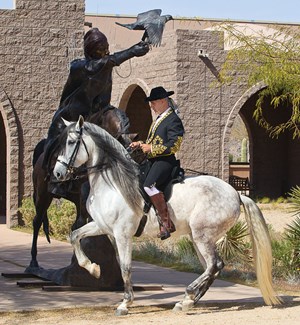
Q: I have noticed that many baroque horse riders wear paddock boots instead of tall boots. Is this a fashion statement or a tradition with a purpose behind it? Also, what type of spurs should be worn with paddock boots?
Jennifer Lacey
Ithaca, New York
Manuel Trigo

A: The tradition of wearing botines (paddock or short boots) goes back to the 18th century. At that time in central and southern Europe, riders wore the traje Goyesco, a suit similar to the one worn by bullfighters today. Its jacket was waist length and the trousers (calzona de machos) reached just below the knee, where there was a five-button closure. Men wore white socks high enough to pass the knees. When riding, they added half chaps (polainas) and spurs to their short boots.
For shows today, the riders of the Spanish School of Jerez wear different types of traje Goyesco suits with brown short boots and brown Spanish half chaps. Riders of the Portuguese school use the casaca Federica style from the 18th century (a coat that is short in front and tapers in back to match or fall slightly below the bottom of the knee-length trousers) with black half chaps and black short boots.
The current rulebook for alta escuela (high school riding) requires the rider to wear short boots with half chaps when dressing Goyesco style or traje corto—in a Spanish suit. Nowadays the trousers are about 10 inches longer but still feature a five-button closure at the ankle, and they are worn with paddock boots and half chaps. In contrast, when attired in white breeches for Iberian riding, a rider uses tall boots.
Concerning spurs: Each type stems from a particular discipline and has a specific goal. Spanish spurs, like most of the tack, were developed for vaqueros (Spanish cowboys) and bullfighters. The vaqueros, who work with cattle, sometimes have no other choice than to use their spurs to escape safely from a difficult situation. However, Spanish spurs differ greatly from the ones other cowboys in the world wear. They are made from black iron, like Spanish bits, and are small in size—less than an inch—with various wheel options. The most traditional wheel has eight points—four small ones and four longer ones.

Customarily before using new spurs, the rider rubs the wheel on a stone or hard ground to blunt each point. Then the spur is fixed low on the heel of the boot using a white or brown strap.
Today riders use both strap colors interchangeably. In the past, however, it was believed that a riding student first had to master his discipline before being allowed to wear white straps.
In short: Riders had to earn their spurs. I share this point of view. My students are allowed to use spurs only after being able to ride in lightness.
Manuel Trigo is a master of doma vaquera, alta escuela and natural horsemanship. He offers what he calls “lightness tournaments” and gives clinics in the U.S., Mexico and Costa Rica. A native of Spain, he divides his time between Arizona and Colorado (trigomanuel.com).












